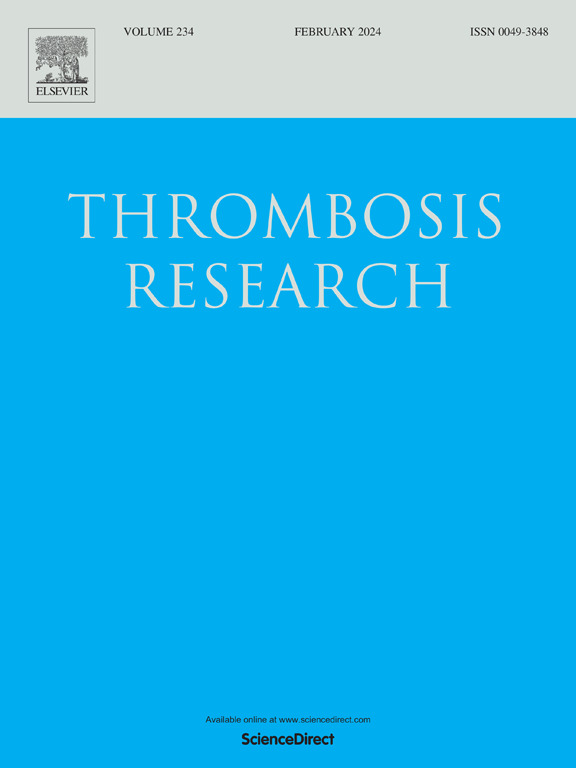Selected cell receptor genotypes differentially modulate the ABO blood group influence on Factor VIII levels in severe aortic stenosis
IF 3.7
3区 医学
Q1 HEMATOLOGY
引用次数: 0
Abstract
Background
Altered blood flow, which characterizes aortic stenosis (AS), influences von Willebrand factor (VWF) conformation and enhances ADAMTS13 cleavage, potentially influencing factor VIII (FVIII) clearance and plasma levels.
Aim
To investigate whether ABO blood group and genetic variants of cellular receptors involved in VWF/FVIII clearance may interact with AS in determining genotype-driven FVIII levels.
Patients/Methods
FVIII:c levels were analyzed in patients with severe AS (SAS, n = 115), with coronary artery disease and without valvular heart disease (CAD, n = 300), and healthy subjects (HS, n = 172), clustered according to ABO and receptor genotypes. Variants with functional association with receptor mRNA and/or FVIII levels, localized in 5 receptors (LDLR, STAB2, SCARA5, ASGR2, CLEC4M) with different VWF/FVIII binding properties, were selected.
Results
In SAS group, a significant interaction between ABO and receptor genotypes in modulating FVIII:c levels was observed with positive B values for lectins (ASGR2 and CLEC4M) and negative for LDLR and STAB2. The lectin variants, as well as their combinations, showed significantly lower FVIII levels in the non-O group with high glycan expression and potentially improved FVIII binding and increased clearance. Differently, the non-lectin LDLR and STAB2 variants, and their combinations, were associated with genotype-driven high FVIII levels, particularly in the O group. All these patterns were not observed in CAD or HS groups.
Conclusion
These observations suggest that differential interaction between genotypes of specific cellular receptors and ABO blood group may contribute to high/low FVIII:c levels in O/non-O blood group subjects, respectively, and to the large inter-individual variability of FVIII levels in SAS.
选择性细胞受体基因型差异调节ABO血型对严重主动脉瓣狭窄患者因子VIII水平的影响
背景:主动脉狭窄(AS)的特征血流失调影响血管性血液病因子(VWF)构象,增强ADAMTS13裂解,可能影响因子VIII (FVIII)清除率和血浆水平。目的探讨参与VWF/FVIII清除的细胞受体的ABO血型和遗传变异是否与AS相互作用,以决定基因型驱动的FVIII水平。患者/方法分析严重AS患者(SAS, n = 115)、合并冠状动脉疾病且无瓣膜性心脏病患者(CAD, n = 300)和健康受试者(HS, n = 172)的sfviii:c水平,并根据ABO和受体基因型进行聚类。选择与受体mRNA和/或FVIII水平有功能关联的变异,这些变异定位于5个具有不同VWF/FVIII结合特性的受体(LDLR、STAB2、SCARA5、ASGR2、CLEC4M)。结果在SAS组中,ABO与受体基因型在调节FVIII:c水平方面存在显著的相互作用,凝集素(ASGR2和CLEC4M)的B值为阳性,LDLR和STAB2的B值为阴性。凝集素变异体及其组合,在高聚糖表达的非o组中,FVIII水平显著降低,并可能改善FVIII结合和增加清除率。不同的是,非凝集素LDLR和STAB2变体及其组合与基因型驱动的高FVIII水平相关,特别是在O组。所有这些模式在CAD组和HS组均未观察到。结论特异性细胞受体基因型和ABO血型之间的差异相互作用可能导致O/非O血型受试者FVIII:c水平分别高/低,并导致SAS患者FVIII水平存在较大的个体差异。
本文章由计算机程序翻译,如有差异,请以英文原文为准。
求助全文
约1分钟内获得全文
求助全文
来源期刊

Thrombosis research
医学-外周血管病
CiteScore
14.60
自引率
4.00%
发文量
364
审稿时长
31 days
期刊介绍:
Thrombosis Research is an international journal dedicated to the swift dissemination of new information on thrombosis, hemostasis, and vascular biology, aimed at advancing both science and clinical care. The journal publishes peer-reviewed original research, reviews, editorials, opinions, and critiques, covering both basic and clinical studies. Priority is given to research that promises novel approaches in the diagnosis, therapy, prognosis, and prevention of thrombotic and hemorrhagic diseases.
 求助内容:
求助内容: 应助结果提醒方式:
应助结果提醒方式:


